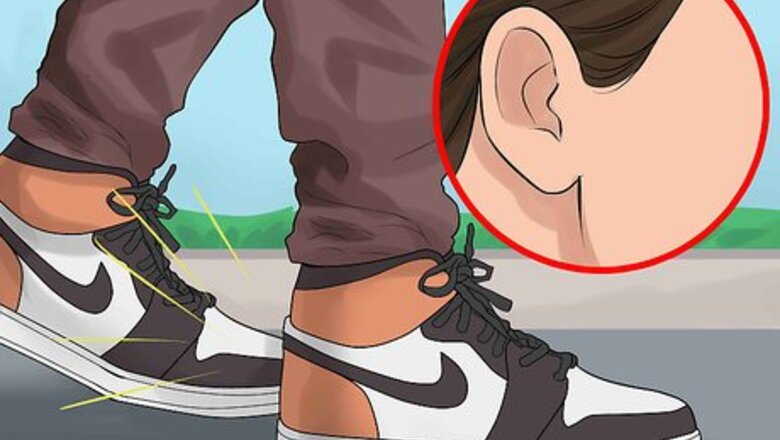
views
Locating the Squeak

Listen carefully to the squeaky shoe. Listen carefully to the shoe when it squeaks to hear the source of the squeaking. Place pressure on different parts of your foot with the shoe on. Rock it back and forth. Stand up on your toes. Most likely, the source of the squeaking will be the insole of your shoe. In some cases, friction from the tongue of the shoe may cause squeaking also. Visible damage to your shoe, like holes in its fabric or rubber, can sometimes cause squeaking. If you know the source of the squeaking, you'll be able to target this area with de-squeaking techniques, which may resolve your problem faster.
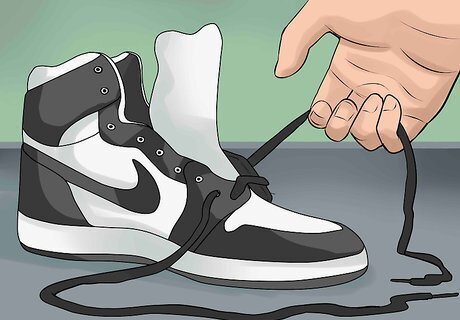
Unlace the shoe. This will give you easier access to the insole, which can be difficult to remove for Jordans. Pull the laces through the metal grommets of the shoe until they come free. Place them off to the side in a safe place.
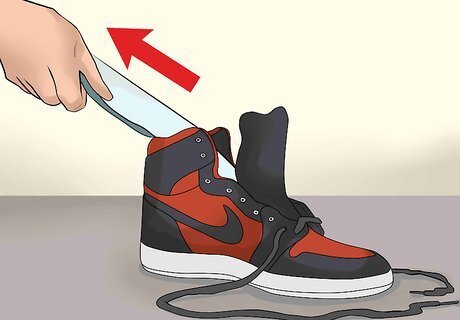
Remove the insole. If your insole is not glued down, it will pull free easily. If it is glued, pull the tongue to further open the shoe. Work your fingers between the side of the shoe and the side of the insole. With firm, steady pressure, peel the insole up and remove it. Be careful not to pull too hard, as this may damage or deform the insole. Replacement insoles can be bought at shoe stores, drug stores, and general retailers. Some glue may remain on the bottom of the insole or sole. It may also be tacky. This is normal and should not harm your shoe.
De-squeaking Soles

Sprinkle baby powder in the sole-less shoe. Hold the shoe so its toes point on a slight downward angle. Apply several shakes of baby powder or talcum powder to the inside of the shoe. Upright the shoe and tilt it back and forth to distribute the powder. Massage the powder lightly with your hands into areas of the sole the squeak seemed to come from. To more thoroughly ingrain the powder in the sole, replace the insole and wear the shoe for 10 to 15 seconds, then remove the insole.
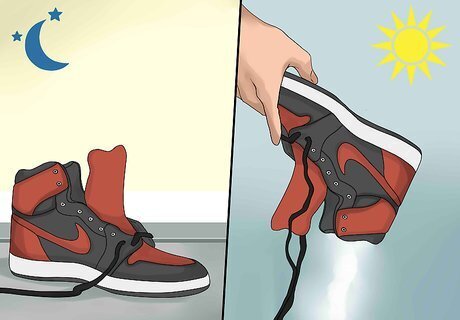
Remove excess powder from the shoe. For the best results, allow powder to remain in the shoe overnight. In the morning, upend the shoe over a garbage. Shake and tap it lightly to remove the powder. To maintain the shape of the shoe while it sits overnight, insert a couple of pieces of bunched newspaper into it. Remove and throw away the paper in the morning.
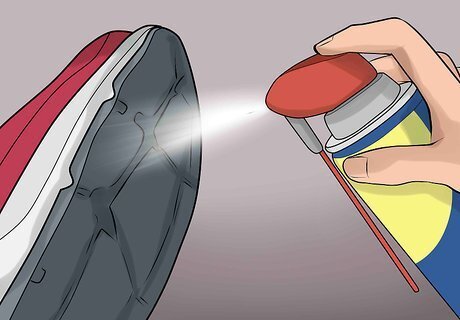
Cure squeaking with WD-40, alternatively. Take your shoes outside and/or lay a drop cloth or newspaper beneath them to catch any spills. Spray a thin layer of WD-40 over the entire sole. Apply WD-40 more precisely by soaking a cotton ball or swab in the solution and rubbing the ball or swab on the sole. When the WD-40 is dry to the touch, your shoe is ready for its insole. Wash WD-40 from your hands to prevent eye or skin irritation. If WD-40 gets on a visible part of your shoe, it may cause discoloration. Using too much WD-40 may be harmful to the shoe.
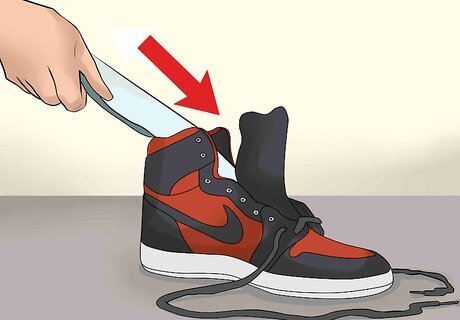
Re-insert the sole and test the shoe. Slip the insole back into the shoe. Without lacing the shoe, insert your foot and take a few steps. If there is no squeaking, re-lace the shoe and enjoy your de-squeaked kicks.
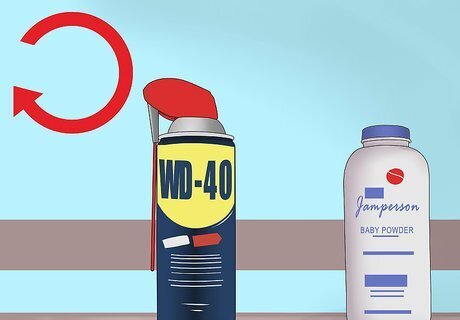
Reapply powder or WD-40 as necessary. Over time, your shoes may start squeaking again. This can usually be solved by another application of powder or WD-40. Shoes that squeak constantly likely have a physical defect and may require professional repair.
Repairing Squeak-Causing Damage
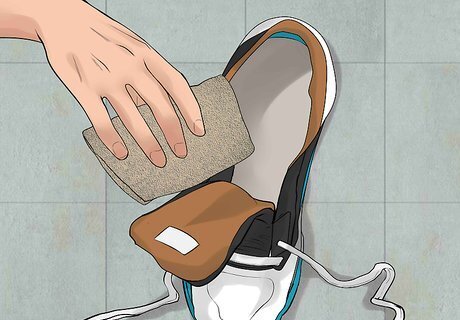
Sand away squeaking caused by shoe tongues. If the tongue of your shoe is squeaking, this is likely caused by friction between a part of the tongue and the rest of the shoe. Pull the tongue as free of the shoe as you are able and lightly sand its edges with a fine grit rating (120 to 220 grit) sandpaper. Depending on the material of your shoe, you may want to use a finer or coarser sandpaper. Extra fine sandpaper (240+ grit rating) may be best for delicate material. Avoid sanding visible parts of the tongue if it can be helped. Although sanding will smooth rough spots creating squeaks, it may cloud or deform the surface of shoe material.
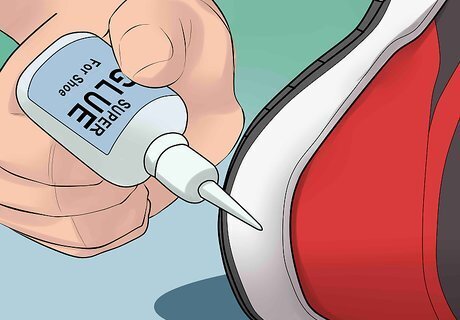
Mend damage or loose heels with glue. If a small hole or loose heel is the source of the squeaking, you can repair this with glue. Use water and heat resistant urethane rubber for soles. Super glue works well for repairing holes for most shoe material. Follow the glue directions for best results. Some glues may contain chemicals that do damage to the rubber or material of your shoe. When in doubt, consult a shoe repair professional on the best glue for your particular shoe.
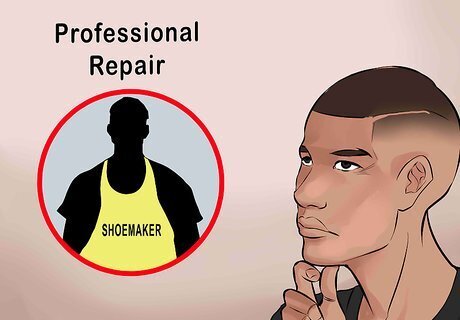
Have a professional repair the squeaky shoes. If none of these de-squeaking techniques worked, there may be a physical defect with your shoe at the root of the problem. In most cases, these kinds of repairs can only be made by professionals with special tools. As shoes are broken in, they should squeak less. If your shoes continue to squeak even after being broken in, this may be a sign your shoes are in need of professional repair.










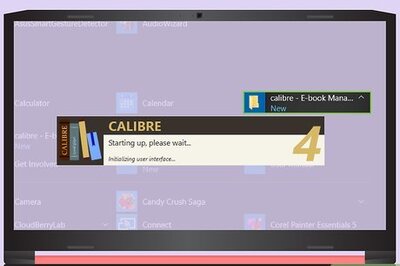






Comments
0 comment